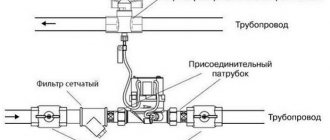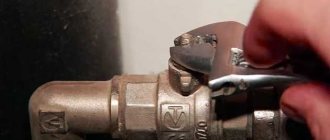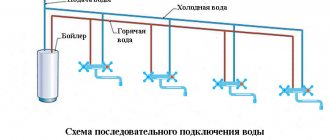Danfoss thermostats can be installed independently, but for this you need to know the direction of movement of the coolant (you can find out from the operating company) and what type of heating system you have, or rather single-pipe or two-pipe; this information can also be obtained from the operating company.
Sometimes it becomes necessary to adjust the temperature in each specific room. This can be done by installing a thermostat for the heating radiator. This is a small device that regulates the heat transfer of a heating battery. Can be used with all types of radiators, except cast iron. One important point is that the device can lower the initial temperature, but if there is not enough heating power, it cannot increase it.
Design of thermostats for heating radiators
The thermostat for a heating radiator consists of two parts - a valve (thermovalve) and a thermostatic head (thermostatic element, temperature regulator). These products are produced for different pipe sizes and different types of heating systems. The thermostatic head is removable; regulators of different types and even from different manufacturers can be installed on the same valve - the seat is standardized.
The thermostat for a heating radiator consists of two parts - a special valve (valve) and a thermostatic head (regulator)
There are different valves and regulators, so before installing a thermostat for a heating radiator, you will have to become at least a little familiar with its structure, functions and types.
About Danfoss regulators
Why install a thermostat? To maintain a certain indoor air temperature.
p, blockquote 3,0,0,0,0 —>
The product consists of two parts that complement each other:
p, blockquote 4,0,0,0,0 —>
- Thermostat.
- Thermostatic valve.
The Danfoss thermostat valve is connected directly to the radiator, and a thermostat is already mounted on it.
p, blockquote 5,0,0,0,0 —>
The main thing is a thermostatic element that senses temperature changes and sends a signal to a valve that shuts off the flow of coolant.
p, blockquote 6,0,1,0,0 —>
Inside the thermal head is a bellows (a corrugated chamber that can change sizes) with gas. At a certain temperature, a gas changes its state (it condenses when cooled). This affects the change in volume and pressure in the chamber, which becomes smaller in size and pulls the spool rod, which in turn opens a gap in the valve for the circulation of the coolant.
Thermal valve - structure, purpose, types
The valve in the thermostat is very similar in structure to a regular valve. There is a seat and a shut-off cone that opens/closes the gap for coolant flow. The temperature of the heating radiator is regulated in this way: by the amount of coolant passing through the radiator.
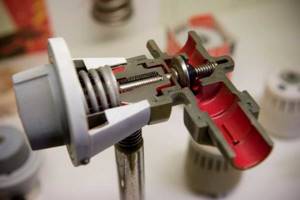
Sectional view of thermostatic valve
The valves are installed differently for one-pipe and two-pipe wiring. The hydraulic resistance of a valve for a one-pipe system is much lower (at least two times) - this is the only way to balance it. You can't mix up the valves - it won't heat. For systems with natural circulation, valves for single-pipe systems are suitable. When installing them, the hydraulic resistance, of course, increases, but the system will be able to work.
Each valve has an arrow indicating the movement of the coolant. During installation, it is installed so that the flow direction coincides with the arrow.
What materials?
The valve body is made of corrosion-resistant metals and is often additionally coated with a protective layer (nickel or chrome plated). There are valves from:
- bronze (nickel and chrome plated);
- brass (coated with a layer of nickel);
- of stainless steel.
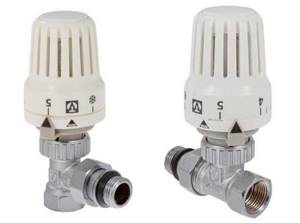
Cases are usually brass or bronze with nickel or chrome plating
It is clear that stainless steel is the best option. It is chemically neutral, does not corrode, and does not react with other metals. But the cost of such valves is high and it is difficult to find them. Bronze and brass valves have approximately the same service life. What is important in this case is the quality of the alloy, and it is carefully monitored by well-known manufacturers. Whether or not to trust unknowns is a controversial issue, but there is one point that is better to keep track of. There must be an arrow on the body indicating the direction of flow. If it is not there, then you have a very cheap product that is better not to buy.
By method of execution
Since radiators are installed in different ways, the valves are made straight (through) and angular. Choose the type that will work best for your system.
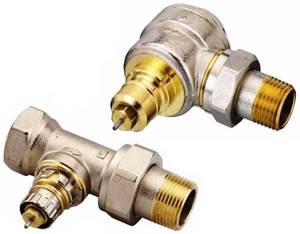
Straight (way through) valve and angle
| Name/Company | For which system | Du, mm | Housing material | Operating pressure | Price |
| Danfos, angular RA-G, adjustable | single-pipe | 15 mm, 20 mm | Nickel plated brass | 10 bar | 25-32 $ |
| Danfos, direct RA-G with customizability | single-pipe | 20 mm, 25 mm | Nickel plated brass | 10 bar | 32 — 45 $ |
| Danfos, angular RA-N, adjustable | two-pipe | 15 mm, 20 mm. 25 mm | Nickel plated brass | 10 bar | 30 — 40 $ |
| Danfos, direct RA-N with customizability | two-pipe | 15 mm, 20 mm. 25 mm | Nickel plated brass | 10 bar | 20 — 50 $ |
| BROEN, direct fixed tuning | two-pipe | 15 mm, 20 mm | Nickel plated brass | 10 bar | 8-15 $ |
| BROEN, direct fixed tuning | two-pipe | 15 mm, 20 mm | Nickel plated brass | 10 bar | 8-15 $ |
| BROEN, corner, adjustable | two-pipe | 15 mm, 20 mm | Nickel plated brass | 10 bar | 10-17 $ |
| BROEN, corner, adjustable | two-pipe | 15 mm, 20 mm | Nickel plated brass | 10 bar | 10-17 $ |
| BROEN, direct fixed tuning | single-pipe | 15 mm, 20 mm | Nickel plated brass | 10 bar | 19-23 $ |
| BROEN, fixed angle | single-pipe | 15 mm, 20 mm | Nickel plated brass | 10 bar | 19-22 $ |
| OVENTROP, axial | 1/2″ | Nickel plated brass, enamel plated | 10 bar | 140 $ |
Design features
The main purpose of the Danfoss thermostat is to long-term maintain the user-selected temperature regime. The design of the device includes two main parts:
- thermostatic element or, as it is also called, a thermostat;
- valve.
The valve is first mounted on the battery and only the thermostat is installed on it. It is the second element that is the main one in the design of the device. It monitors the ambient temperature, after which it sends the necessary signal to the valve, which in turn opens or closes the coolant flow.

Design of Danfoss thermostatic valves
In the internal area of the Danfoss thermostat there is a bellows - a corrugated container filled with gas or liquid. When exposed to temperature, the filler begins to change size and put pressure on the shut-off valve. When the coolant flow in the heating units is blocked, the temperature begins to increase.
If the room has become very cold, the filler contracts and a reverse reaction occurs - the chamber pulls the spool rod behind it, which in turn opens the gap in the valve element for coolant to flow in.
The company produces two types of thermostats - gas and liquid. But the second option is considered more inert; it gives a signal to change the temperature regime much slower.
Types and symbols of devices
The type of filler and purpose are determined by the following abbreviation:
- RTS – liquid bellows

- RTD-G - gas device for a one-pipe or two-pipe system in which there is no pump
Valve RTD-G-20 for one-pipe system
- RTD-N – gas device for single-pipe, two-pipe pumping systems
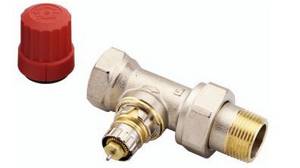
Thermostat valve RTD-N-15
In some models, in addition to the main function, there are a number of additional options. For example, a program to protect against interference in the installed settings by random persons. The option will be convenient for installation in public institutions or children's institutions. The number of modes and types of functions vary depending on the selected modification.
Model range of devices
The company produces a fairly wide range of Danfoss heating temperature controllers.

Types of shut-off valves
The most popular variations are:
- Danfoss RDT marking 3640 - the device is intended for use on standard two-pipe heating systems. It is equipped with an RTD option, which prevents freezing of the main line during the cold season. Used in domestic and industrial conditions. It has four divisions with designations in the form of Roman numerals.
- The Danfoss RAX regulator is a liquid type of device that is used for installation on designer-type radiators or heated towel rails. It has attractive external parameters and a minimalist style. On the case there are only divisions with Roman or Arabic numerals.
- Living ECO with the function of monitoring the microclimate in the house. This is an improved series that is successfully used in commercial establishments and residential buildings. The peculiarity of the thermostat for a heating radiator is that it has a liquid crystal screen that provides all the necessary information about the coolant. There are also three main mode setting keys on the case.
- The Danfoss RA-299 gas appliance with automated temperature control is available in several colors. It responds quickly to temperature changes. It is used exclusively for equipping traditional heating systems.
- 013 G4 001-013 G4 009 – multifunctional series of devices suitable for both heated towel rails and various areas of the heating device. There are left- and right-handed types.
How to install correctly
They install a thermostat for a heating radiator at the inlet or outlet of the heating device - there is no difference, they work with equal success in both positions. How to choose a place to install?
According to the recommended installation height. There is such a clause in the technical specifications. Each device is configured at the factory - they are calibrated to control the temperature at a certain height and usually this is the upper radiator manifold. In this case, the heat regulator is installed at a height of 60-80 cm; it is convenient to adjust it manually if necessary.
Classification of thermostatic valves
You should know that preliminary adjustment devices are adjusted by a specialized specialist, and open ones can always be adjusted on your own.
The full classification is presented in the following order:
- installation method (straight, corner, radiator);
- type of heating system (the device involves one or two pipes);
- type of coolant (liquid, gas, paraffin);
- type of adjustment - manual, automatic, autonomous (the valve is located outside the system, mounted separately).
In matters of functionality, as well as the right choice, you can always trust our specialists, who are worthy representatives of the brand from Denmark.
How to adjust (reconfigure)
All thermostats are factory adjusted. But their settings are standard and may not match your desired parameters. If you are not satisfied with something in the work - you want it to be warmer/colder, you can reconfigure the thermostat for the heating radiator. This must be done with the heating running. You will need a thermometer. You hang it at the point where you will control the state of the atmosphere.
- Close the doors, put the thermostat head in the extreme left position - completely open. The room temperature will begin to rise. When it becomes 5-6 degrees higher than what you want, turn the regulator all the way to the right.
- The radiator begins to cool down. When the temperature drops to a value that you consider comfortable, begin to slowly turn the knob to the right and listen. When you hear the coolant making noise and the radiator starting to warm up, stop. Remember what number is on the handle. It will need to be set to achieve the required temperature.
Adjusting the thermostat for a radiator is not difficult at all. And you can repeat this action several times, changing the settings.
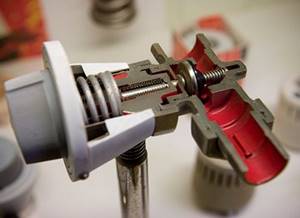
Installing a thermostat on a radiator is an opportunity to reduce heating costs, improve the microclimate in the house, and also carefully use the earth's energy resources.
The motives may be different, but the decision is being implemented more and more often.
Many people, when choosing an equipment manufacturer, choose Danfoss.
And not surprisingly, products from a well-known brand can easily be found on the shelves of many stores.
The production technology of their thermostats based on a gas-filled bellows is patented and used in the company’s own factories. If you also decide to purchase a Danfoss thermostat, the installation and operating instructions will come in handy.
Setting the Thermostat
All the manufacturer’s devices are distinguished externally and in terms of technical characteristics, but they are still configured in the same way. To perform it, you need to look at the operating instructions and get acquainted with the designation of the modes that are indicated on the device body. Indicators may vary, depending on the model.
Next, to adjust the Danfoss thermostat, set it to the desired temperature. This can be created by moving the torque element in some direction. If you have installed a device with buttons, all you need to do is press the plus or minus button.
It is possible to show intermediate values when they are best suited to create a certain temperature regime in the room. A couple of minutes will pass, and the heating system will have time to adapt to the specified parameters and will warm until a good climate emerges. The same applies to refrigeration equipment.
Thermostats for heating radiators Danfoss
The purpose of installing a thermostat is to maintain the air temperature in the house chosen by the consumer.
The design of a thermostat for radiators includes two elements that complement each other:
- Thermostat (or thermostatic element).
- Danfoss thermostat valve.
The valve is connected directly to the battery, and a thermostatic element is installed on it.
The heart of the matter is the thermostat. It is he who reacts to changes in ambient temperature and affects the valve that blocks the flow of coolant.
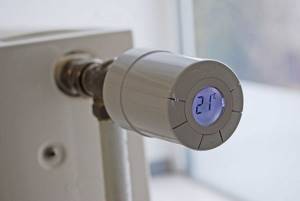
Inside the thermostat head is a bellows (a corrugated chamber capable of changing dimensions) filled with gas. The gas, depending on the temperature, changes its state of aggregation (when cooled, it condenses). This leads to a change in volume and pressure in the chamber. The chamber decreases in size and pulls the spool rod with it, which opens a larger gap in the valve for the flow of coolant.
When heated, a reverse process of expansion and closure of the lumen occurs (the accepted standard is 2 V ° C in excess of the air temperature above the set one).
When a comfortable temperature is set on the regulator scale, a certain compression of the tuning spring is established inside, which is interconnected with a certain gas pressure.
Temperature regulators for Danfoss battery - device, types, installation, configuration
4 December 2021, 19:15
Thermostats installed on heating radiators can increase indoor comfort and also significantly save on heating costs. In this article, a master plumber will tell you about Danfoss regulators for heating radiators.
The Danish company Danfoss A/S is an international concern producing heating and refrigeration equipment. The company was founded in 1933 and is headquartered in Norborg (Denmark).
The range includes automation equipment for heating, ventilation and air conditioning complexes of buildings. Factories produce shut-off and control valves.
Many years of experience in the design and manufacture of specialized equipment allows the company to produce competitive products. According to experts, up to 30% of thermal automation devices in Russia are supplied by Danfoss. All products comply with European quality standards.
Comfort means maintaining different temperature conditions in the rooms and areas of an apartment or private house. It is impossible to do this in conditions of centralized heating without control equipment for several reasons:
- The radiator has strict parameters and when the temperature of the coolant changes, it will heat up more or less, regardless of the owner’s wishes.
- The coolant temperature is the same at the radiator inlet in all rooms of the apartment and depends only on the operation of the boiler room.
- If too hot water (steam) is supplied, the rooms will be hot, stuffy and dry.
The only way to regulate the microclimate is to install a thermostat.
- By changing the position of the adjusting head, the thermostat on the Danfoss battery is set to the required operating mode.
- At a low temperature in the room, the regulator valve is in the open position and the coolant flows into the radiator without restriction - the battery operates at full capacity, the room warms up.
- When the required temperature is reached, the regulator gradually shuts off the coolant flow, directing part of the hot water bypassing the battery through the central riser - the battery gives off less heat, and the temperature in the room drops.
The speed and accuracy of response of Danfoss thermostats for heating radiators depends on the design of the device.
Any designs of Danfoss radiator thermostats are built and operate according to a similar functional scheme. There are valves with manual and automatic adjustment.
In the case of manual adjustment, the user closes or opens the coolant supply to the radiator as necessary. The method is inconvenient to use in autumn and spring, when the temperature changes significantly during the day.
The valve of the automatic device opens or closes when the air temperature in the room changes without human intervention.
The automatic device includes:
- Thermal head housing with a regulator and setting scale located on it.
- A bellows filled with gas condensate liquid or gas.
- Crane axle box that controls the operation of the valve.
- Fittings for installation on the pipes supplying coolant to the radiator.
The principle of operation is that, depending on the air temperature in the room, the gas in the bellows expands when heated or contracts when cooled. When expanding, the movable part of the thermal head moves the rod and valve, changing the size of the hole through which the coolant enters the radiator. When the gas in the bellows cools, the rod moves the valve to the open position - the battery heats up more.
Special liquids, paraffin, gas or gas condensate are used as a bellows filler. Research data from the Rhine-Westphalian University of Technology shows that gas-filled regulators have the best parameters in terms of speed and accuracy of response.
The patent for the invention of gas devices belongs to Danfoss and only this company produces such equipment.
Main technical characteristics
The consumer qualities of the product and its safety are important to the user.
The product consists of two parts that complement each other:
- Thermostat.
- Thermostatic valve.
The Danfoss thermostat valve is connected directly to the radiator, and a thermostat is already mounted on it.
Any temperature controller for a Danfoss battery is guaranteed to withstand the following parameters:
- Working pressure in the system is up to 10 Atm;
- Test pressure - up to 16 atm;
- The maximum coolant temperature is 120 degrees;
- The temperature control limits are from 5 to 26 degrees.
When choosing, pay attention to the connecting dimensions of the regulator. The company's product range includes equipment for 10, 15, 20 and 25 mm.
There are cases designed for direct or angular connection, which is taken into account when purchasing. If necessary, purchase additional fittings.
When purchasing devices powered by electricity, pay attention to the way the regulator is powered: from batteries, mains, or from a power supply.
Advantages and disadvantages
Installers of heating equipment note the positive qualities of Danfoss radiator thermostats:
- Save up to 50% energy by maintaining the user’s desired room temperature. This property is especially important in private houses or apartments equipped with individual heat metering devices.
- Fast automatic response to changes in room temperature.
- Easy installation on any standard radiators, available range of adapters and fittings for pipes of any size and any pipeline configuration. Installation on systems with bottom, top, corner connections in one- and two-pipe systems.
- Reliability and long service life subject to operating rules.
- The presence of locking functions against unauthorized removal and disassembly, which is important for safety, especially for protecting children from burns.
- Modern design.
- Possibility of purchasing a device with a remote temperature sensor, which can be installed at a distance of up to 5 m from the radiator. The option helps to maintain the desired level of comfort anywhere in the room.
Types and symbols:
- RTS—liquid bellows;
- RTD-G - gas bellows for a one-pipe system, or two-pipe without a pump;
- RTD-N - gas bellows for two-pipe systems and systems with a circulation pump.
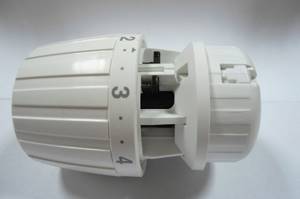
Radiator thermostat DANFOSS RA 2991
There are also modifications of thermoelements in which:
- Protection is provided against reconfiguration by random persons (an excellent option for public institutions and children's rooms).
- There is an external temperature sensor connected by a two-meter capillary tube, which can be installed away from the radiator, buried in a niche or filled with furniture, which gives a more accurate measurement result.
- With a temperature range slightly smaller than conventional sensors for integration into a system where payment is made according to regulations.
Video on the topic
Danfoss thermostats can be installed independently, but for this you need to know the direction of movement of the coolant (you can find out from the operating company) and what type of heating system you have, or rather single-pipe or two-pipe; this information can also be obtained from the operating company. When installing a thermostat in a single-pipe system, it is necessary to provide a bypass or jumper.
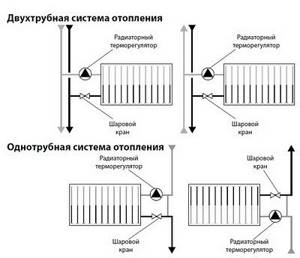
The arrow on the valve body must coincide with the movement of the coolant. For correct operation of the thermoelement, the axis of the valve stem must be in a horizontal position.

Floor heating system
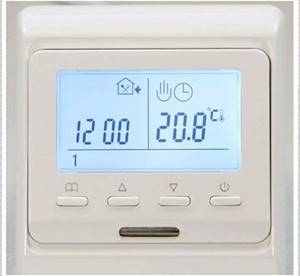
A thermostat for heated floors is a must! After all, when driving liquid into the floor contour, you need to lower its temperature from 60 - 90 V ° C to a comfortable 35 - 40 V ° C (in this case, the surface of the floor itself will be about 25 V ° C).
Flow meters are powerless if the pressure in the system fluctuates, if the air is heated, for example, from the sun, and even if residents want to save on heating while they are away.
The thermomechanical regulator is best used for small rooms, about 10 m2.
Installation of the thermostatic element
First of all, the valve is mounted on the radiator. To do this, the coolant supply is shut off.

- Markings are made on the supply pipe. The area that will need to be cut should be the same length as the valve body minus the threaded connections.
- The heating pipe is cut and the extra section is cut out.
- Using a die, or die, a thread is made on the outside of the cut pipe.
- The connection is treated with plumbing paste and fum tape.
- The valve body is screwed onto the resulting thread.
- Since the pipe cannot be twisted, an American union nut is twisted on the opposite side of the valve, and then screwed (with a hex wrench) into the radiator hose.
- The body of the device is screwed into its own union nut through a rubber washer. This connection does not need to be sealed in any way, the main thing is that it is clean.
- After the valve is installed on the radiator, the protective cap is removed from it (located perpendicular to the pipe).
How to remove Danfoss thermal head
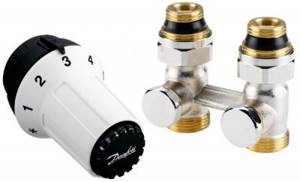
Reading time: 7 minutes Don't have time?
The link to the article has been successfully sent!
We will send the material to you by e-mail
If it is necessary to automatically regulate the temperature in the interior, a thermal head for a heating radiator is used in combination with a thermostatic valve. A set of this equipment allows you to get different temperatures in each room without human intervention.
Thermal head for heating radiator
Classification and principle of operation
Separately from the valve, the thermal head for the heating radiator is completely useless, since there is a sensor inside it that is triggered by changes in the temperature in the room. The bellows chamber contains a solid, liquid or gaseous substance that changes volume.
Thermal head and valve separately
The chamber is connected to a rod that either completely closes the thermostatic valve or opens it to an adjusted level. This is the main difference between a thermal valve and a control valve, which can be used to slightly reduce/increase the flow of coolant inside the heating register.
Thermal head device
Thermal head and valve in section
Attention! A thermal head for a heating radiator with a valve can only be installed in bypass systems of single-pipe systems. When the valve is activated, the flow is completely blocked, so the circulation in the heating circuits stops. The bypass bypass pipe completely solves the problem.
Thus, a valve is first cut into the coolant supply pipe to the heating radiator, and the thermal head is screwed onto it perpendicular to the liquid flow. There are several modifications of the thermal head:
- for single-pipe systems - produced by a limited number of companies, for example, models RA-G, RTD-G from Danfoss;
- for two-pipe systems - in any store, 97% of the assortment of heads are of this type.
Thermal head for one-pipe and two-pipe heating distribution systems
Heads for a 2-pipe system can be visually distinguished by the size of the adjusting cap and color. Devices for single-pipe heating circuits are larger and have a gray or white color. Small diameter red caps are installed on heads for two-pipe systems with high pressure, low flow.
Arrows on the housing indicate the direction of coolant flow; installation against the arrow is prohibited. Therefore, when choosing, you need to take into account whether hot water flows from below or from above into the radiators of different rooms of the apartment.
The operating principle of a thermal head for a heating radiator is extremely simple:
- the user sets the required value for the air temperature in the room, for which the device has a scale with divisions (for example, 21 degrees usually corresponds to value 3);
Adjusting the thermal head scale
- when the temperature rises by 1 degree, the substance inside the bellows chamber will heat up, increase in volume, and press on the valve stem;
Thermal head operation in a system without bypass
- the supply of hot water to the battery will be completely shut off, but circulation in the heating circuits will continue through the bypass;
Design differences between one-pipe and two-pipe systems
- an inoperative register will lead to a decrease in temperature, the volume of the substance in the bellows will decrease, the pressure on the rod will disappear, and the valve will open.
The technology for regulating the room temperature in this case is effective only for radiators with minimal inertia. Bimetallic, aluminum, and steel batteries cool/heat faster, so they are optimally suited for automatic adjustments by thermal heads. Cast iron radiators take a long time to heat up, accumulate heat, and take longer to cool down, so the effectiveness of adjustments by thermal heads is reduced.
Sensor installation
As already mentioned, a remote sensor is needed if the battery is built into the wall or covered by something (furniture, screen, thick curtains).
A sensor and a setting unit are combined in one housing of this element.
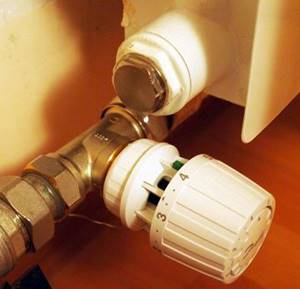
- It is best to place the device on an open (but without drafts) section of the wall, at a height of about 1.4 m from the floor. You need to avoid places near appliances that can greatly change the temperature of the environment - air conditioners, stoves, etc.
- The device comes with a small mounting panel, which is secured to the selected location using a pair of self-tapping screws.
- A capillary tube is wound inside the sensor. It is pulled out to the required length so that the device reaches the fixed bar.
- The capillary tube is carefully fixed on the back of the valve.
- The sensor is placed on the bar by simply snapping it into place.
The microclimate in the house and air humidity are two inextricably linked concepts. Air humidifiers - benefits and harm for your home and health, read about this in the article.
Which insulation for a heated floor to choose, read in this topic. You will also find general information about laying insulation.
Danfoss thermostats: model range
Over its considerable history, Danfoss has released many models of thermostats, many of which are updated and re-released to this day.
The most popular models are thermal heads of the series:
Thermostat RTR 7000 (RA 2000)
RTR 7000 series thermostats
have options with built-in and remote air temperature sensor.
The design is specially designed for RA class radiators. The capillary tube of the latter reaches eight meters in length. A special outer casing protects the thermostatic element from external negative influences. Almost all models in the series have a gas bellows, valve shut-off function and frost protection. The temperature setting range
is on average from +5 to +26 °C.

The series includes such models as: Danfoss RTR 7090
with built-in sensor,
RTR 7092
with remote sensor,
RTR 7094
with protective housing.
Thermostat RTRW (RTRW)
RTRW series thermostats
have not many differences from RTR 7000. Contain a liquid agent.
Also available with remote and built-in sensor. The temperature setting range
varies from + 8 to + 28 °C.
The RTRW type includes models: RTRW 7080 with a built-in sensor, RTRW 7082 with a remote sensor.

Thermostat RTRW-K (RAW-K)
Thermal heads RTRW-K
are practically a copy of the previous thermostatic element. The difference is that RTRW-K are more versatile and suitable for many types of heating radiators, including: steel panel radiators such as Biasi, Delta, DiaNorm, Diatherm, Ferroli, Henrad, Kaimann, Kermi, Korado, Purmo, Radson, Superia , Stelrad, Veha, Zehnder-Completto Fix.
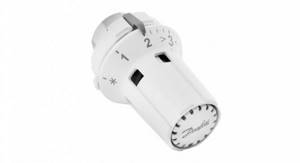
Temperature setting range
from +8 to +28 °C. The device is equipped with the ability to protect the heating system from freezing.
The RTRW-K series includes: RTRW-K 7084 with built-in sensor, RTRW-K 7086 with remote sensor.
Thermostat RAX
RAX series thermostatic head
is a thermostat with a liquid built-in temperature sensor.
The elegant design of this product harmonizes with even the most sophisticated interior. A distinctive feature of the RAX is the tuning scale with Roman numerals. Temperature setting range
from +8 to +28 °C.

The series has several modifications in the body color range: white, black, chrome and steel.
Setting a limit
The operation of thermostats is based on physical laws. Therefore, you need to remember that the conditions in which the device is located may make some adjustments (for example, distance from the heat source). There are indicative tables of correspondence between the regulator scale and temperature, which can be taken as a guide during installation. However, after the basic setup, you will need to “understand” your thermostat.
- Set the temperature on the handle with marks.
- After an hour, control measurements are taken with a room thermometer at several points in the room.
- If the temperature is higher or lower, the readings on the handle are adjusted.
Proportional band - 2 °C. If you set the temperature to 20°, the device will maintain readings in the range from 20 to 22 °C.
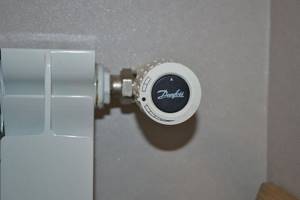
Sensor after installation on the radiator
The two pins that are included with the sensor will help set the limits for the minimum and maximum positions of the thermoelement.
They are located at the bottom of the device:
- To set the limit to o, you need to pull out the limiter and set the sensor readings to o. Then the pin is inserted into the hole, which in this position is under the diamond icon.
- The second limiting threshold is set in the same way. The handle is turned to the desired value, only the pin is inserted into the hole located under the triangle icon.
- Both pins are removed.
- The handle is placed at the desired level.
- In this position, the first pin is inserted into the hole located under the diamond.
- The second pin goes into the hole under the triangle.
Danfoss thermostats have many positive reviews. This is a very easy to use device that does not require any attention after initial installation and configuration. But the result will be a more comfortable temperature in the apartment, and in some cases, significant budget savings.
Popular models of Danfoss thermostats
The company's product range includes many different Danfoss thermostats for batteries. The following are popular:
p, blockquote 13,0,0,0,0 —>
- RTD regulator marked 3640. It is used on 2-pipe classical type heating systems. Equipped with an option that prevents the line from freezing in cool weather. The Danfoss RTD thermostat is used in domestic and industrial environments and has four divisions with marks in the form of Roman numerals.
- The designation RAX, as a rule, is for products with liquid that are used for installation on unusual batteries or on heated towel rails. Externally they are very attractive and fit well into the design. The case has only divisions with Roman and Arabic numerals.
- The Danfoss RA-299 thermostat operates on gas, has automatic temperature control, and is available in different colors. Reacts quickly to temperature fluctuations. Can only be used for installation on classic heating systems.
- The Living ECO device has the option of indoor climate control. It can be safely installed in various administrative buildings and residential buildings. The product is distinguished by the presence of an LCD screen, which displays all the necessary data about the thermal fluid. In addition, the case has main buttons for mode settings.
- There are also series with many functions; they are suitable for heated towel rails and for different areas of heating equipment. Can be right- or left-handed.

Danfoss Living Connect thermostat
All Danfoss thermostats for heating radiators are supplied with parts that simplify the installation of the device and its future use.

